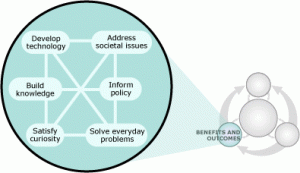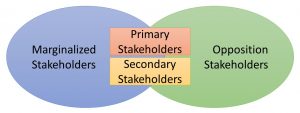2 Stakeholders and Authority
Andrea Bierema
Learning Objectives
- Identify different types of authority, such as subject expertise, societal position, or individual experience.
- Recognize that a given information source may not give voice to all—or even the majority— of stakeholders involved in and impacted by an issue, such as conservation.
- Identify and explain the roles of primary, secondary, opposition, and marginalized stakeholders in a given case study.

What is a Stakeholder?
Stakeholders are people, institutions, or social groups that are affected by, and/or involved in, a particular issue, such as the creation of policies. While this definition is seemingly straightforward, it is often difficult to answer fundamental questions such as:
- Who are “the people?”
- What does “institution” mean?
- What are the limits of a “social group?”
Yet, these questions must be answered if the right stakeholders are to be identified and mobilized.
Types of Stakeholders
There are stakeholders who directly influence, or are influenced by, outcomes (called “primary stakeholders”) and others that indirectly affect, or are affected by, outcomes (called “secondary stakeholders”). Some of these stakeholders may be marginalized stakeholders or opposition stakeholders. See below for definitions.

Exercise
Answer the following questions after reading through the different types of stakeholders.
Stakeholder Influence on Decision-Making
In some cases, stakeholders are easy to identify. In other cases, a more in-depth understanding of the issues involved in a particular situation is needed to determine who should be included in the early phases of the process. For a variety of reasons, stakeholders may disagree about who should be included in the dialogue. It may be that a group is perceived as too combative, or is not thought to have the appropriate skills to participate effectively. These objections may or may not be justifiable and may often be the result of historic biases held by stakeholder groups. While assumptions are inevitable, it is important that the initial stakeholder identification process avoids reaching premature conclusions about which stakeholders should, or should not, be involved.
Initially, dialogue should be as open and participatory as possible, encouraging stakeholders from a variety of backgrounds and perspectives to contribute to the identification and framing of collaboration goals and objectives. If the process is not participatory, there is a risk that it will quickly become dominated by the strongest, loudest, or best-resourced groups who seek to shape the process for their own objectives. Over time, it may be determined that additional interests must be brought into the dialogue and the process needs to be open enough to facilitate this.
Given the challenges that “open participation” in a collaboration process brings (in terms of multiple, often conflicting perspectives and interests), many groups choose to promote collaboration more gradually. In these cases, “start-up” involves bringing together like-minded groups and allies. Steering committees can be established by these groups to formulate shared goals and objectives and assess and strengthen capacities before a wider collaboration process is initiated.
In some instances, initial dialogue may lead to consortiums, alliances, or coalitions. While this approach can provide for a strong and coherent voice, there are associated risks. These include the premature establishment of partnerships before issues, opportunities, and appropriate stakeholder roles and responsibilities have been fully defined. When alliances with only like-minded groups are formed, the risk of generating negative reactions among other stakeholders can increase due to perceived “exclusivity.” Effective information sharing, communication, and public education can help alleviate these risks. Development of a strategic plan for progressively bringing in other key stakeholders—primary, secondary, or opposition—will also be essential.
The number of parties engaged in the collaboration process is also an important consideration. All stakeholders do not need to participate all the time, or to the same degree. A review of who is participating in a conservation initiative should be made on a regular basis, and participation revised as needed.
Differences in Power
Power differentials exist in all forms of social organizations and between social groups. The source of these differences may be based on the heredity rights that leaders enjoy in certain cultural settings, or the power differences earned through channels that economic and political opportunity afford individuals and groups.
Two power issues are particularly relevant to facilitators of stakeholder collaboration: addressing power inequalities between key parties so that adequate representation and collaboration can be achieved, and reaching agreements among parties on how a disagreement over issues will be resolved.
Conflicts involving core group values and identity are difficult to resolve. For example, less politically powerful stakeholders may fear that a powerful outsider will impose its views on a process. This may provoke them to withdraw from a given negotiation process even if they stand to benefit from staying involved. Similarly, distrust can make it particularly difficult for the parties to begin constructive talks. Facilitators need to understand the source of this distrust and determine what, if anything, can be done to remove it.
In situations that become polarized around opposing values or identities, facilitators of a collaboration process need to be resourceful in sensitizing participants to the validity of different stakeholder perspectives. Instrumental techniques such as adapting the meeting structure and process to better enable constructive cross-stakeholder learning can be useful.
Stakeholder Scenarios
The following is a series of scenarios that illustrate the stakeholder concepts described above.
Attributions
This chapter is a modified derivative of the following article:
“Stakeholder Collaboration: Building Bridges for Conservation” by Ecoregional Conservation Strategies Unit, World Wildlife Fund, 2000, Washington, D.C.: World Wildlife Fund, Public Domain.
Media Attributions
- benefits and outcomes © University of California Museum of Paleontology's Understanding Science
- Stakeholder Types © Andrea Bierema
people, institutions, or social groups that are affected by and/or involved in a particular issue, such as the creation of policies

